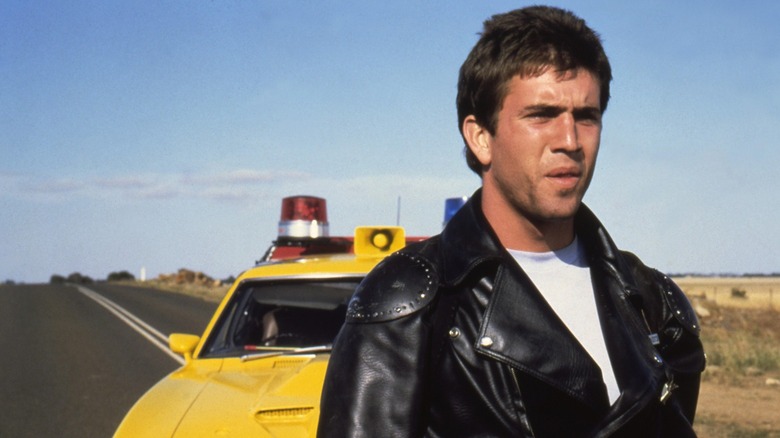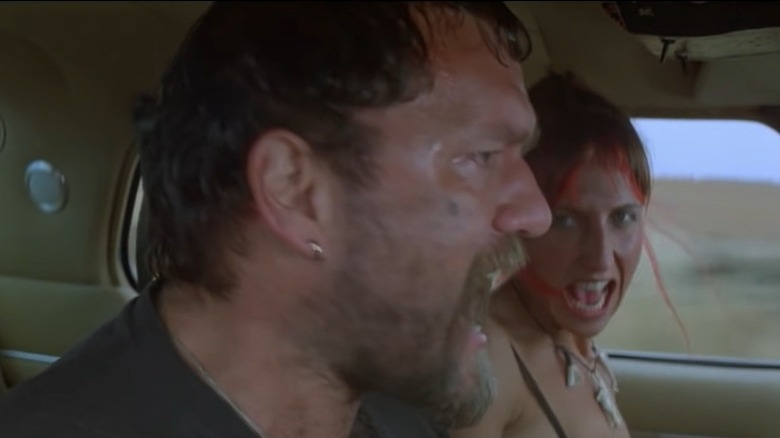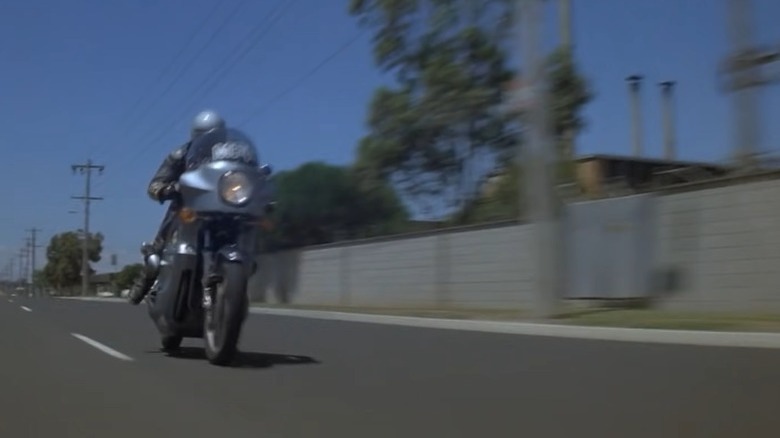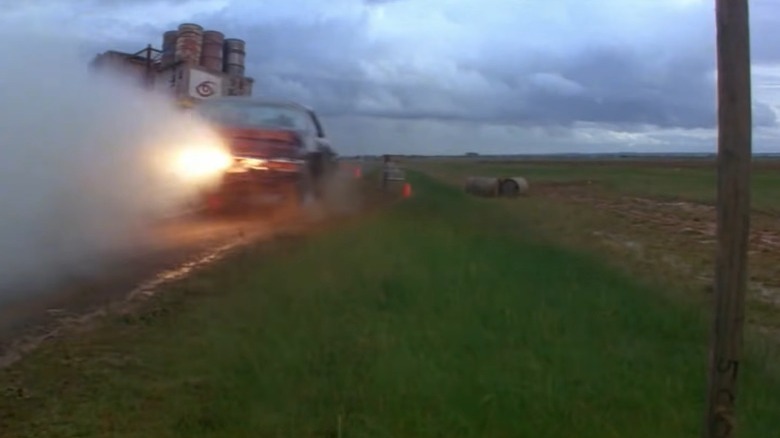How The Mad Max Crew Built A Real Rocket Car (And How It Almost Killed Them)
The only clue 1979's "Mad Max" gives to its vaguely dystopian timeframe is in the opening title card, which places the setting as "a few years from now." Besides that, anything goes, and in the movie's largely handmade universe, that fact was a blessing. In lieu of having a substantial budget, director George Miller made a movie that practically doubled as a documentary of the seedier elements of Greater Melbourne, Australia in the 1970s.
Despite the movie's obviously heightened sensibilities, its filmmakers opted for realism. Real bikers, real cars, real explosions, and even real rockets that were attached to modded cars so they could fly forward with greater speed. According to Luke Buckmaster's "Miller and Max," Miller had assembled an excitable crew to make his post-apocalyptic biker thriller, and anybody in Australia with an interest in blowing things up found common cause with him.
In particular, the rocket that got rigged up to the back of a car was one of the movie's riskiest inventions, something with murderous potential that would, in the final film, take up less than a second of time. But seeing the movie, any viewer knows how indispensable that moment is, how it immediately plunges you into this dangerous, suicidally edgy world. After all, nearly 40 years later, George Miller employed some of the same dangerous methods to make eye-popping car chases in 2015's "Mad Max: Fury Road."
It's in the movie's opening chase, just as titular cop Max (Mel Gibson) is getting involved in the action. Nightrider (Vincent Gil) is on the run, evading police capture with a gleam in his eyes. But Max is the master of pursuit — he gets Nightrider to drive straight into a roadblock at high speed, rocket-assisted, and into an explosion. It's a testament to the movie's brilliant stunt and pyrotechnic team that the rocket fuel and explosion look remarkable even now.
A few years from now
With "Mad Max," if somebody had an idea for something in the movie, director and co-writer George Miller, who didn't even feel particularly responsible for the movie's eventual success, let them do that. He was making a portrait of civilization at the end of its rope, drawing from such disparate events as the 1973 oil crisis and his own time as a doctor in Sydney, having witnessed just some of the horrors that made it into the movie.
Because of that, "Mad Max" feels comfortably like a lived-in, slightly anachronistic future, whether in its fashions (like the leather jackets the movie made look incredibly cool) or even in its cars (from late '50s hot rods to early '70s modified sedans). Meanwhile, Miller's high-intensity story and rapid cutting only needs to spare a couple of lines on exposition.
As a lo-fi dystopia, the movie often feels like a group of guys getting together to enact horrific vehicle-on-vehicle violence. The iconic low-budget DIY feeling is present in the car chases, stunts, and explosions, and the threat of real consequences is palpable. There is a dangerous edge to the movie, in its characters' desperate living and visible injuries. The line that "people don't believe in heroes anymore" feels honest to the movie's colorful, unhinged cast — besides being a general comment on the story's amorality.
Still, it's a simple story, a bit like an Australian take on "Walking Tall" or any number of contemporary American lawman-turned-vigilante movies. The only difference is just how extreme it goes, how dark and gnarled its moral landscape is, and how violent its action can get. The rocket in the car is just one example.
Murray's rocket
Of course, "Mad Max" was not exactly "Fury Road" in terms of its sensibility and worldbuilding. Certain kinks needed to be worked out. In many ways, it fits into the biker exploitation movie model that was popular in the late '70s, more than the apocalyptic sci-fi for which the series would be known. It's a heightened world, but one that doesn't feel terribly distinct from the time period outside of its sense of chaos. The evil biker gang terrorizing a young couple on a country road is a frightening scene reminiscent of "A Clockwork Orange" that reflects the movie's dystopian aspirations, but it's more upsetting because of its tangible reality.
With a relatively low budget of just $350,000, the only way to make the movie's most outrageous moments feel authentic was in walking the line between realism and sci-fi. Enter the rocket car, the movie's most notorious example of a need for speed.
According to Luke Buckmaster's "Miller and Max," the Nightrider sequence was one of the last to be filmed for the movie, despite being its opening act. At that point, the crew had become seasoned veterans of putting together wild stunts in rural Victoria, with an experimental excitement about whatever they could do next. How could they best bring to life Max's pursuit of Nightrider? Why not a rocket?
Given that Nightrider's actor Vincent Gil had only just learned to drive, he was awkwardly wedged in the car with stunt coordinator Grant Page, who would really be handling the complicated maneuvers. Meanwhile, pyrotechnician Chris Murray proposed the rocket solution, switching out the car's engine for a rocket in a couple of key shots that would spell out Nightrider's doom.
Rodinga Booster
In the movie, it's surprisingly graceful to see the character and car's demise, with the big burst of flames just before it careens into stacks of gasoline barrels. There's nothing better to kick off the movie's wild ride through apocalyptic Australia. And Chris Murray, responsible for equipping the vehicle with a rocket, knew it would be worth the hassle he was going through.
Per Luke Buckmaster's "Miller and Max," Murray received an empty rocket motor casing from a Maribyrnong munitions factory, and was promised a Rodinga Booster down the line. That Australian-made rocket would, once properly installed, move the car at a speed of 200 km/h. Murray and some knowledgeable friends, like Australian Broadcasting Commission's special effects expert David Hardie (who allegedly told Murray, "Don't be stupid") worked on the car every night, running physics calculations and making sure the plan would go off without a hitch.
The next phase of the plan was actually filming it. The extreme danger involved meant that it would be risky even trying to film the rocket car launch, but director George Miller committed to operating one camera. Producer Byron Kennedy and operator Tim Smart would each work another, and then they would take a getaway car from George's brother Bill to get as far from the blast as they could.
It was good that they did. The rocket had blasted the car outside of the cable track that Murray had built for it, and while some onlooking crew worried that the rocket car had gone airborne, George Miller knew what had really happened — it was headed directly in the same direction as the getaway car.
Luckily for everybody involved, it veered away at the last second. More importantly for the filmmakers, the footage looked incredible. Even if Miller felt he had made some major filmmaking errors with "Mad Max," it would be hard to call the rocket car one of them.



